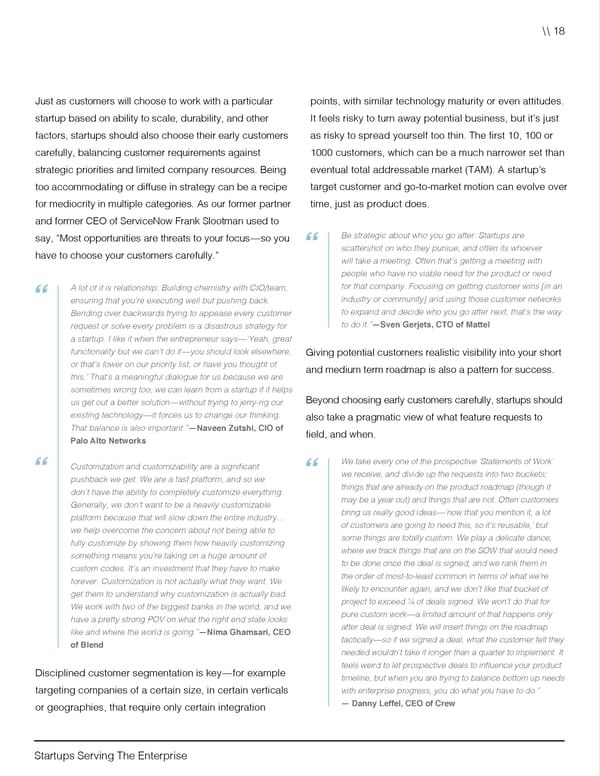\\ 18 Just as customers will choose to work with a particular points, with similar technology maturity or even attitudes. startup based on ability to scale, durability, and other It feels risky to turn away potential business, but it’s just factors, startups should also choose their early customers as risky to spread yourself too thin. The first 10, 100 or carefully, balancing customer requirements against 1000 customers, which can be a much narrower set than strategic priorities and limited company resources. Being eventual total addressable market (TAM). A startup’s too accommodating or diffuse in strategy can be a recipe target customer and go-to-market motion can evolve over for mediocrity in multiple categories. As our former partner time, just as product does. and former CEO of ServiceNow Frank Slootman used to say, “Most opportunities are threats to your focus — so you Be strategic about who you go after. Startups are have to choose your customers carefully.” “ scattershot on who they pursue, and often its whoever will take a meeting. Often that’s getting a meeting with people who have no viable need for the product or need A lot of it is relationship. Building chemistry with CIO/team, for that company. Focusing on getting customer wins [in an “ ensuring that you’re executing well but pushing back. industry or community] and using those customer networks Bending over backwards trying to appease every customer to expand and decide who you go after next, that’s the way request or solve every problem is a disastrous strategy for to do it.”—Sven Gerjets, CTO of Mattel a startup. I like it when the entrepreneur says — ‘Yeah, great functionality but we can’t do it — you should look elsewhere, Giving potential customers realistic visibility into your short or that’s lower on our priority list, or have you thought of and medium term roadmap is also a pattern for success. this.’ That’s a meaningful dialogue for us because we are sometimes wrong too, we can learn from a startup if it helps Beyond choosing early customers carefully, startups should us get out a better solution — without trying to jerry-rig our existing technology — it forces us to change our thinking. also take a pragmatic view of what feature requests to That balance is also important.” —Naveen Zutshi, CIO of field, and when. Palo Alto Networks Customization and customizability are a significant We take every one of the prospective ‘Statements of Work’ “ pushback we get. We are a fast platform, and so we “ we receive, and divide up the requests into two buckets; don’t have the ability to completely customize everything. things that are already on the product roadmap (though it Generally, we don’t want to be a heavily customizable may be a year out) and things that are not. Often customers platform because that will slow down the entire industry… bring us really good ideas — ‘now that you mention it, a lot we help overcome the concern about not being able to of customers are going to need this, so it’s reusable,’ but fully customize by showing them how heavily customizing some things are totally custom. We play a delicate dance, something means you’re taking on a huge amount of where we track things that are on the SOW that would need custom codes. It’s an investment that they have to make to be done once the deal is signed, and we rank them in forever. Customization is not actually what they want. We the order of most-to-least common in terms of what we’re get them to understand why customization is actually bad. likely to encounter again, and we don’t like that bucket of We work with two of the biggest banks in the world, and we project to exceed ¼ of deals signed. We won’t do that for have a pretty strong POV on what the right end state looks pure custom work — a limited amount of that happens only like and where the world is going.”—Nima Ghamsari, CEO after deal is signed. We will insert things on the roadmap of Blend tactically — so if we signed a deal, what the customer felt they needed wouldn’t take it longer than a quarter to implement. It Disciplined customer segmentation is key — for example feels weird to let prospective deals to influence your product timeline, but when you are trying to balance bottom up needs targeting companies of a certain size, in certain verticals with enterprise progress, you do what you have to do.” or geographies, that require only certain integration — Danny Leffel, CEO of Crew Startups Serving The Enterprise
 Startups Serving The Enterprise Page 18 Page 20
Startups Serving The Enterprise Page 18 Page 20